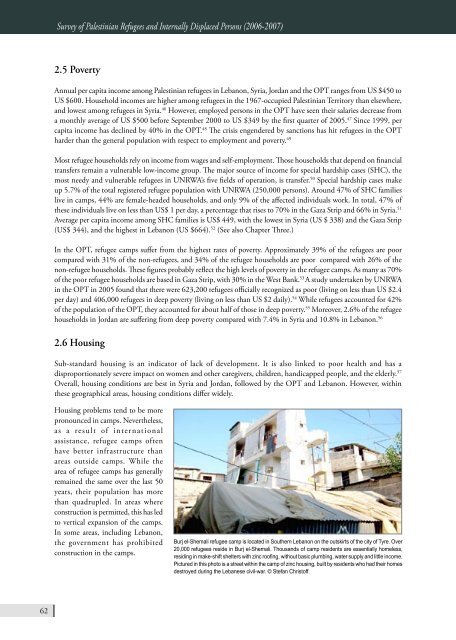BADIL Resource Center for Palestinian Residency and Refugee
BADIL Resource Center for Palestinian Residency and Refugee
BADIL Resource Center for Palestinian Residency and Refugee
You also want an ePaper? Increase the reach of your titles
YUMPU automatically turns print PDFs into web optimized ePapers that Google loves.
62<br />
Survey of <strong>Palestinian</strong> <strong>Refugee</strong>s <strong>and</strong> Internally Displaced Persons (2006-2007)<br />
2.5 Poverty<br />
Annual per capita income among <strong>Palestinian</strong> refugees in Lebanon, Syria, Jordan <strong>and</strong> the OPT ranges from US $450 to<br />
US $600. Household incomes are higher among refugees in the 1967-occupied <strong>Palestinian</strong> Territory than elsewhere,<br />
<strong>and</strong> lowest among refugees in Syria. 46 However, employed persons in the OPT have seen their salaries decrease from<br />
a monthly average of US $500 be<strong>for</strong>e September 2000 to US $349 by the first quarter of 2005. 47 Since 1999, per<br />
capita income has declined by 40% in the OPT. 48 The crisis engendered by sanctions has hit refugees in the OPT<br />
harder than the general population with respect to employment <strong>and</strong> poverty. 49<br />
Most refugee households rely on income from wages <strong>and</strong> self-employment. Those households that depend on financial<br />
transfers remain a vulnerable low-income group. The major source of income <strong>for</strong> special hardship cases (SHC), the<br />
most needy <strong>and</strong> vulnerable refugees in UNRWA’s five fields of operation, is transfer. 50 Special hardship cases make<br />
up 5.7% of the total registered refugee population with UNRWA (250,000 persons). Around 47% of SHC families<br />
live in camps, 44% are female-headed households, <strong>and</strong> only 9% of the affected individuals work. In total, 47% of<br />
these individuals live on less than US$ 1 per day, a percentage that rises to 70% in the Gaza Strip <strong>and</strong> 66% in Syria. 51<br />
Average per capita income among SHC families is US$ 449, with the lowest in Syria (US $ 338) <strong>and</strong> the Gaza Strip<br />
(US$ 344), <strong>and</strong> the highest in Lebanon (US $664). 52 (See also Chapter Three.)<br />
In the OPT, refugee camps suffer from the highest rates of poverty. Approximately 39% of the refugees are poor<br />
compared with 31% of the non-refugees, <strong>and</strong> 34% of the refugee households are poor compared with 26% of the<br />
non-refugee households. These figures probably reflect the high levels of poverty in the refugee camps. As many as 70%<br />
of the poor refugee households are based in Gaza Strip, with 30% in the West Bank. 53 A study undertaken by UNRWA<br />
in the OPT in 2005 found that there were 623,200 refugees officially recognized as poor (living on less than US $2.4<br />
per day) <strong>and</strong> 406,000 refugees in deep poverty (living on less than US $2 daily). 54 While refugees accounted <strong>for</strong> 42%<br />
of the population of the OPT, they accounted <strong>for</strong> about half of those in deep poverty. 55 Moreover, 2.6% of the refugee<br />
households in Jordan are suffering from deep poverty compared with 7.4% in Syria <strong>and</strong> 10.8% in Lebanon. 56<br />
2.6 Housing<br />
Sub-st<strong>and</strong>ard housing is an indicator of lack of development. It is also linked to poor health <strong>and</strong> has a<br />
disproportionately severe impact on women <strong>and</strong> other caregivers, children, h<strong>and</strong>icapped people, <strong>and</strong> the elderly. 57<br />
Overall, housing conditions are best in Syria <strong>and</strong> Jordan, followed by the OPT <strong>and</strong> Lebanon. However, within<br />
these geographical areas, housing conditions differ widely.<br />
Housing problems tend to be more<br />
pronounced in camps. Nevertheless,<br />
as a result of international<br />
assistance, refugee camps often<br />
have better infrastructure than<br />
areas outside camps. While the<br />
area of refugee camps has generally<br />
remained the same over the last 50<br />
years, their population has more<br />
than quadrupled. In areas where<br />
construction is permitted, this has led<br />
to vertical expansion of the camps.<br />
In some areas, including Lebanon,<br />
the government has prohibited<br />
construction in the camps.<br />
Burj el-Shemali refugee camp is located in Southern Lebanon on the outskirts of the city of Tyre. Over<br />
20,000 refugees reside in Burj el-Shemali. Thous<strong>and</strong>s of camp residents are essentially homeless,<br />
residing in make-shift shelters with zinc roofing, without basic plumbing, water supply <strong>and</strong> little income.<br />
Pictured in this photo is a street within the camp of zinc housing, built by residents who had their homes<br />
destroyed during the Lebanese civil-war. © Stefan Christoff.

















